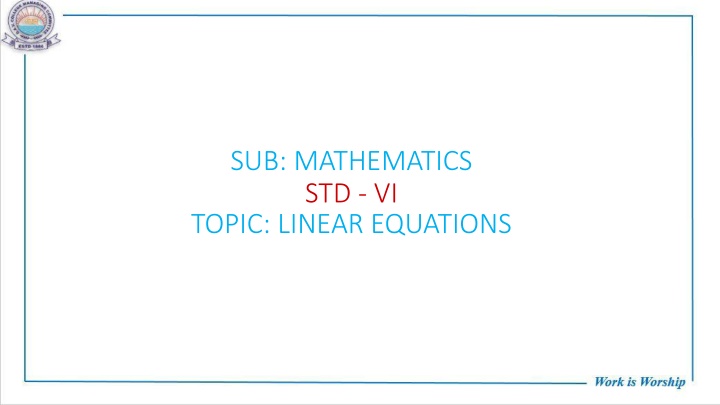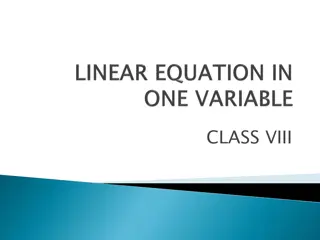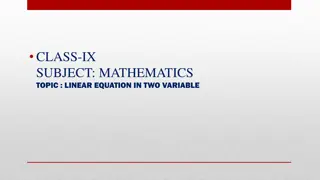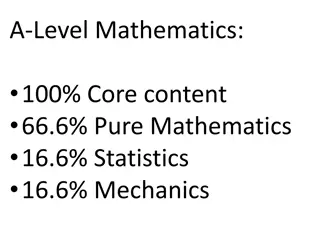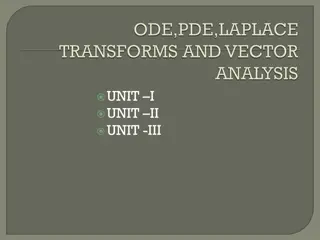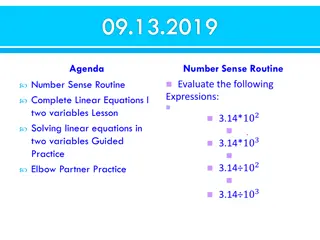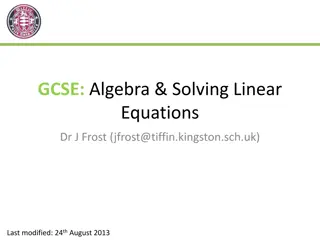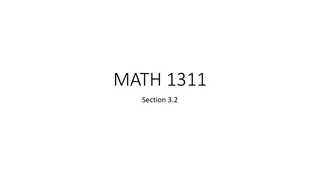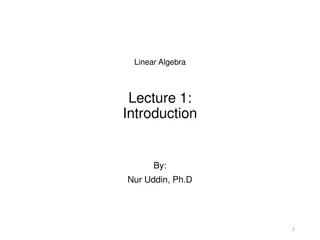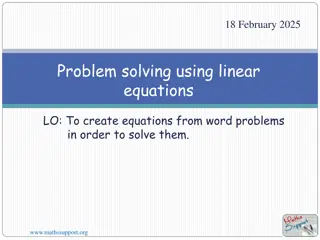Linear Equations in Mathematics
Introduction to linear equations in mathematics for 6th grade students. Learn about the concept of equality, solving first-degree equations, and applications in real-life scenarios. Explore examples and understand the formation of equations from statements.
Download Presentation

Please find below an Image/Link to download the presentation.
The content on the website is provided AS IS for your information and personal use only. It may not be sold, licensed, or shared on other websites without obtaining consent from the author.If you encounter any issues during the download, it is possible that the publisher has removed the file from their server.
You are allowed to download the files provided on this website for personal or commercial use, subject to the condition that they are used lawfully. All files are the property of their respective owners.
The content on the website is provided AS IS for your information and personal use only. It may not be sold, licensed, or shared on other websites without obtaining consent from the author.
E N D
Presentation Transcript
SUB: MATHEMATICS STD - VI TOPIC: LINEAR EQUATIONS
Click on the below link to view the pdf file of chapter linear equations https://drive.google.com/file/d/1Pl9OUJL6sBg Bb2gNXNKTlC6xKgV_zvhG/view?usp=sharing
LEARNING OBJECTIVES LEARNING OBJECTIVES Students will be able to i. understand the concept of equality ii. investigate the meaning of an equation iii. solve first degree equations in one variable with coefficients iv. investigate what equation can represent a particular problem.
INTRODUCTION INTRODUCTION
Imagine that you are taking a taxi while on vacation. You know that the taxi service charges 90 to pick your family up from your hotel and another 15 per km for the trip. After the completion of your trip the taxi driver gave you a bill of 1440. If we take x" to represent the distance in km travelled, the linear equation would be: 15x + 90 = 1440
A statement which states that two algebraic expressions are equal is called an equation. Some more examples: Some more examples: 3X2 + 5 = X 5 3x 2y = 8 6 x = x+9
The equation involving only one variable in first order is called a linear equation in one variable. 3x 5 =0 8 y =2 7 +a =15 3a
A LINER EQUATION IS ALSO CALLED A FIRST DEGREE EQUATION AS THE HIGHEST POWER OF VARIABLE IS 1. EXAMPLE OF LINER EQUATIONS : x + 4 = - 2 2x + 5 = 10 5 3x = 8
Formation of Equation From Statement A number increased by 8 is equal to 15 .Find the number. Solution: let be a number x Given ,the number increased by 8 equal 15. =>x+8 = 15 =>x= 15 -8 => x=7
Formation of statement from equation Formation of statement from equation 2x+5 = 10 Two times a number increased by 5 is equals to 10 x-5 = 12 Five subtracted from a number is equals to 12
ACTIVITY ACTIVITY (Art Integration) (Art Integration) Click to view
PROPERTIES OF AN EQUATION If same quantity is added to both sides of the equation, the sums are equal. Thus: x=7 => x+a=7+a If same quantity is subtracted from both sides of an equation, the differences are equal Thus: x=7 => x-a=7-a If both the sides of an equation are multiplied by the same quantity, the products are equal. Thus: x=7 => ax=7a If both the sides of an equation are divided by the same quantity, the quotients are equal. Thus: x=7 => x a=7 a
3.To solve an equation of the form ax=b Q. Solve 3x=9 Solution: 3x=9 => 3x/3= 9/3 => x = 3 4. To solve an equation of the form x/a=b Q. Solve x/2 = 6 Solution: x/2 = 6 => x = 6x2 => x = 12
SHORT- CUT METHOD (SOLVING AN EQUATION BY TRANSPOSING TERMS) 1.In an equation, an added term is transposed (taken) from one side to the other, it is subtracted. i.e., x+4=10 => x=10-4=6 (4 is transposed) 2. In an equation, a subtracted term is transposed to the other side, it is added. i.e., y-6=5 =>y=5+6=11 3. In an equation, a term in multiplication is transposed to the other side, it is divided. (6 istransposed) 3x=12 =>x=12/3=4 (3 istransposed) 4. In an equation a term in division is taken to the other side it is multiplied. i.e => y=6 4=24 (4 is transposed)
To Solve a Linear Equation by using more than one property Solve: 3x+8=14 Solution: 3x=14-8 (transposing 8) => 3x=6(transposing 3) => x=6/3 =>x=2
(2) 2a-3=5 Solution: 2a-3=5 => 2a=5+3 (transposing 3) => 2a=8 => a= 8/2 (transposing2) => a=4
Solving Equation with variables in both sides Solving Equation with variables in both sides Transpose the terms containing the variable, to one side and the constants to the other side. E.g.: (1) Solve 10y-3=7y+9 Solution: 10y-7y = 9+3 (transposing 7y to the left & 3 to the right) => 3y = 12 => y = 12/3 => y = 4
(2) Solve: 2(x-5) + 3(x-2) = 8+7(x-4) Solution: 2x-10+3x-6 = 8+7x-28(removingthe brackets) => => => => => 5x-16 = 7x-20 5x-7x = -20+16 -2x = -4 x = -4/-2 x = 2
EXAMPLES Q1. Solve x+4=10 (2 Marks) Solution: x+4=10 x+4-4=10-4 (subtracting 4 from both the sides) x=6 [1] [1] Q2. Solve Solution: y-6+6=5+6 (Adding 6 in both sides) => y=11 y-6=5 (2 Marks) y-6=5 [1] [1]
Q3. Solve3(x+5)=18 (4 Marks) Solution: 3(x+5)=18 => 3x+15= 18 (Transposing 15 ) [1] => 3x = 18 -15 [1] => 3x = 3 [1] => x= 3/3 (Transposing 3) [0.5] => x = 1 [0.5]
LEARNING OUTCOMES LEARNING OUTCOMES As a result of studying this topic, students will be able to: 1.solve system of linear equation by substitution/ elimination method. 2.Translate word problems into algebraic expression and equation. 3.Expand the given expression using distributive property. 4.Find out linear equation in one variable has one solution 5.Create equations based on real life situation and solve a system of linear equation 6.corelate real world situations and solve algebraic problems using their knowledge on linear equation.
THANK YOU
